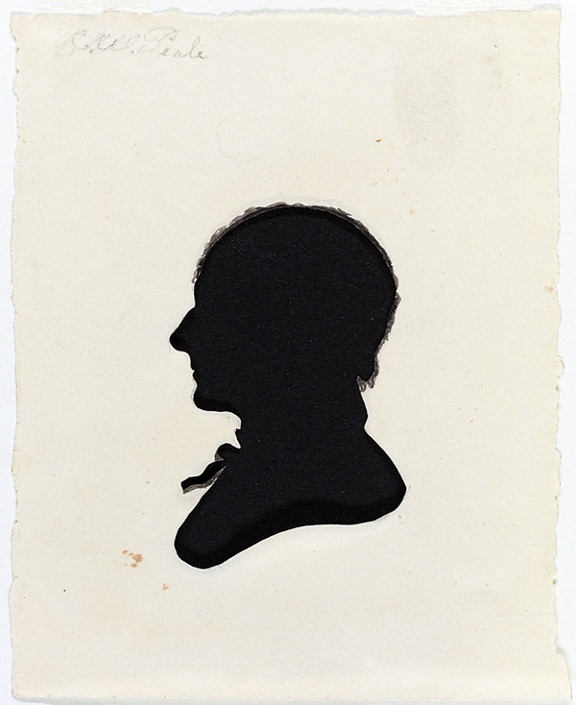Emancipated Artist: Moses Williams
In honor of Juneteenth this week, I present an earlier experience of emancipation—that of artist Moses Williams. When he was 9 years old, Williams’s parents were emancipated. At the time, children of formerly enslaved people were required to remain in the slave owner’s household until the age of 28. This was according to manumission (release from slavery) laws. Williams was born into the household of slave owner Charles Willson Peale (1741–1827), artist and patriarch of the first American dynasty of painters.
 |
| Moses Williams (ca. 1777–ca. 1825), Silhouette of Charles Willson Peale, from the Album of Peale Museum Silhouettes, 1803–1805. Hollow-cut profile with pen and black ink and traces of graphite on wove paper, 4 13⁄16" x 4" (12.2 x 10.2 cm). Image © 2024 Philadelphia Museum of Art. (PMA-5236) |
Born in Philadelphia—also the birthplace of American Democracy (Independence Hall)—Williams created silhouettes, a very democratic art form. They foreshadowed the widespread popularity of photography that began in the 1840s; a medium that, ironically, killed the silhouette and miniature portrait genres. Unlike oil-painted portraits, silhouettes were inexpensive to produce, did not require expensive materials, and were affordable by a large part of the American population.
In order to support himself, it has been estimated that Williams would need to produce 800 silhouettes to every one portrait Peale painted. The Philadelphia Museum of Art contains silhouettes attributed to Williams of all of the members of the Peale family, including Charles Willson himself. This silhouette was produced within a couple years of Williams gaining his freedom around 1802.
Williams was the son of Scarborough and Lucy Peale. By 1776, a Maryland plantation owner had given the biracial couple to Peale as payment for portraits Peale had painted. Pennsylvania banned slavery in 1780 with the Act for the Gradual Abolition of Slavery, which Peale voted for as a member of the Pennsylvania state assembly. Peale freed Scarborough and Lucy in 1786. While enslaved people were often required to take their owner’s last name, Scarborough took the name John Williams after his emancipation. By law, Moses Williams remained indentured in the Peale household, where he trained as a silhouette artist, taxidermist, and display maker for Peale's Philadelphia Museum. While Peale's children were able to pursue their father's interest in painting, Williams was not given the opportunity to paint.
At an early age, Williams developed his talent creating silhouette portraits, at the time called shadow portraits, profile portraits, or shade portraits. He learned to use the newly invented physiognotrace (face-tracing) machine. This device, invented by Gilles-Louis Chrétien (1754–1811), used a lens to transmit the sitter’s likeness to an etching needle. The machine was upgraded in America by John Isaac Hawkins (1772–1855) to trace around the subject’s face with an actual bar connected to a pantograph (a system used to copy drawings in different sizes via a series of connected rods). This reduced the size of the silhouette to less than two inches (5.1 cm).
The origins of silhouette go back to classical antiquity. It emerged as a popular art form in Europe during the 1600s, but the heyday of silhouette was the mid-1700s to the 1840s in both Europe and America. It was not only a profitable profession for skilled artists but was also a fashionable pastime for upper and middle-class people. The art form is named after a French finance minister, Etienne de Silhouette (1709–1767), who cut silhouettes as a hobby (and, some argue, because of the frugality of his fiscal policies). Traditionally, silhouettes were cut from paper that was white on one side (allowing the artist to draw the image, if needed) and black on the other. Variations of the genre were painted silhouettes on paper or ivory, or reverse painting on glass. The most fascinating, by far, are those artists who sit and look at a person’s profile and cut the silhouette on the spot.
Silhouettes were popular in the United States until the 1840s when Daguerreotype and calotype photographs became easier and cheaper methods of portraiture. The genre continued through the late 1800s, although it was no longer fashionable. Williams made hollow-cut silhouettes such as the one shown here from cut light-colored paper placed on a dark background paper, creating a negative image that he augmented with small details in black ink or gouache. This is visible in the wispy hairs Williams added to this silhouette. Williams created and sold his silhouettes at the Philadelphia Museum, a popular offering that attracted more than 8000 customers a year. His artistry and entrepreneurial abilities earned Williams enough money to secure his freedom a year early, purchase a two-story home, marry, and start a family.
Check out my post from 2009 for a silhouette of Charles Willson Peale by William James Hubard.

Comments